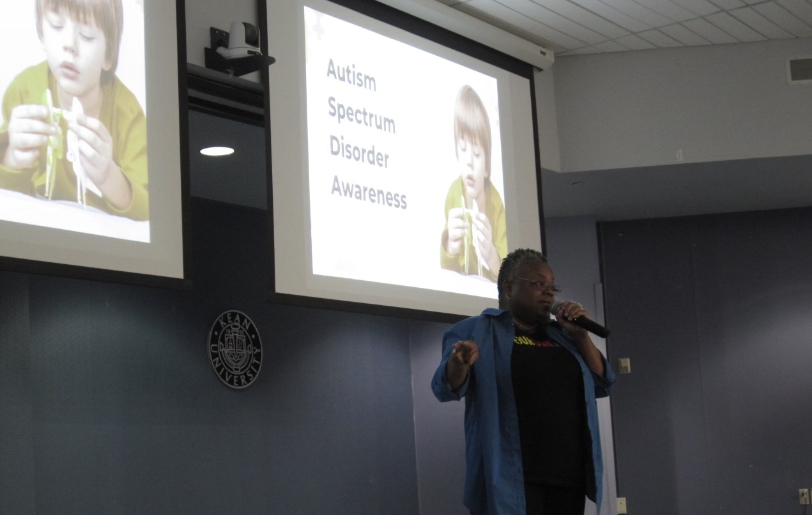By Steven-Ross Bugayong | Published May 3, 2023
April is here, and with it comes World Autism Acceptance Month. This Month celebrates autistic voices, and for some people here at Kean University recognize, advocate and bring awareness to Autism Spectrum Disorder.
Autism Spectrum Disorder affects the way people observe the world. It impacts how people perceive and socializes with others. The disorder may include differences in thinking, processing, and physical moving.

Since 1972, Autism Awareness Month has been celebrated in April, and in 2007, the United Nations adopted April 2 as World Autism Awareness Day. The Autism Society of America, in 2021, advocated for Autism Awareness Month to be changed to Autism Acceptance Month to focus more on perspective-creating connections, empowering everyone in the Autism community to live a life fully rather than pointing out differences.
Matt Girello, a junior majoring in communications, who is on the spectrum, said the most significant effect of being autistic is how he interacts with people.
“There’s a lot of big gatherings I’m uncomfortable in; if there’s a lot of people, I get overstimulated.” Girello said, “I like being in a small group or somewhere less crowded like the movies or comic book stores.”
Marissa Gomez, a sophmore double majoring in Early Childhood Education with Autism Spectrum Disorder and ABA therapy, found her passion for Autism Adovacty early on.
“From a young age, I always knew I wanted to work with kids with special needs because my cousin grew up severely autistic, and I always had a deeper connection with him,” Gomez said. “I was also drawn to the students who needed extra help in my classes as I grew up. I always strive to help them as best as I can.”
According to the National Library of Medicine, “Sex/Gender Differences in Symptomology and Camouflaging in Adults with Autism Spectrum Disorder,” Autism Spectrum Disorder is more prevalent in males than females.
Research by the Center for Disease Control and Prevention states that Autism Spectrum Disorder is nearly four times more common among boys than girls. A possible explanation for this stat is that females on the spectrum have been shown to engage in “camouflaging” (i.e., masking their autistic symptoms) more than males. This evidence suggests that symptoms might be more challenging to detect in females and, consequently, many females on the spectrum may be misdiagnosed.
Most people who advocate for Autism Acceptance Month aren’t on the spectrum but instead are advocates, parents, and loved ones. People who celebrate the Month wear blue on April 2, as blue is the color of autism advocacy.
Emily Wyskowski, a junior majoring in Elementary Education, is the public relations chair for the Council for Exceptional Children. An organization that advocates for students with disabilities by promoting awareness and equity and collaborating with local charities or organizations finds it essential to support Autism Acceptance Month to elevate the voices that may often go unheard.
“Autism Acceptance Month is a pertinent time to use your voice to create change without speaking over others. This advocacy includes listening to the needs of those diagnosed with Autism.” Wyskowski said. “Advocacy helps expose or eliminate discrimination based on disability, as well as to promote an understanding and acceptance of the diversity and prevalence of Autism.”

Irisa Leverette, a Mathematics professor at Kean, said Autism Awareness Month is a time for her to work harder for acceptance and inclusion for her son, Darius, and others with Autism Spectrum Disorder.
“It has always been important, but I think I have a bigger job to do now that Darius, my son, is 18 years old,” Leverette said. “I believe there needs to be more resources to help adults on the spectrum have a better quality of life.”
Aida Perovic, a junior majoring in speech-language-hearing science, has two siblings on the spectrum. She believes Autism Awareness Month is when people join together to educate people on Autism.
“It always makes me happy to see all of the information spread during this time since I feel like there is always more knowledge to be learned and more things we can do, even on a small scale, to help,” Perovic said.
About 1 in 36 children have autism spectrum disorder, the Centers for Disease Control and Prevention states. The growth of autism acceptance is at an all-time high as more children are diagnosed yearly. This was due to many medical professionals not understanding the disorder and children of color often being overlooked.
Autism continues to be a complicated subject. To this day, many people still dont understand what Autism is, and because of the lack of understanding, many misconceptions arise.
A misconception Gomez has heard is that people on the spectrum cannot understand things or communicate.
“Now that I have had some experience working with nonverbal children, although they cannot speak, they are some of the most loving, sweet, and caring children I’ve ever met,” Gomez said.”They might have to be told differently, so they can’t grasp information.”
For Perovic, one misconception that she has heard is that people on the spectrum lack emotions or empathy.
“Just because people with Autism may not always display emotions as we do, does not mean they aren’t there,” Pervovic said. “The people with Autism who aren’t as expressive are still feeling, but how they show it is different. It can take time to learn what’s what.”
There’s always room for people to be more educated; with the prevalence of Autism in America, it has become vital for people to learn and accept the disorder.
“I hope the one thing people get from Autism acceptance month is that they should listen to people on the spectrum,” Girello said. “Cause they have loud and proud voices out there and were tired of being silenced by a neurotypical society.”

You must be logged in to post a comment.